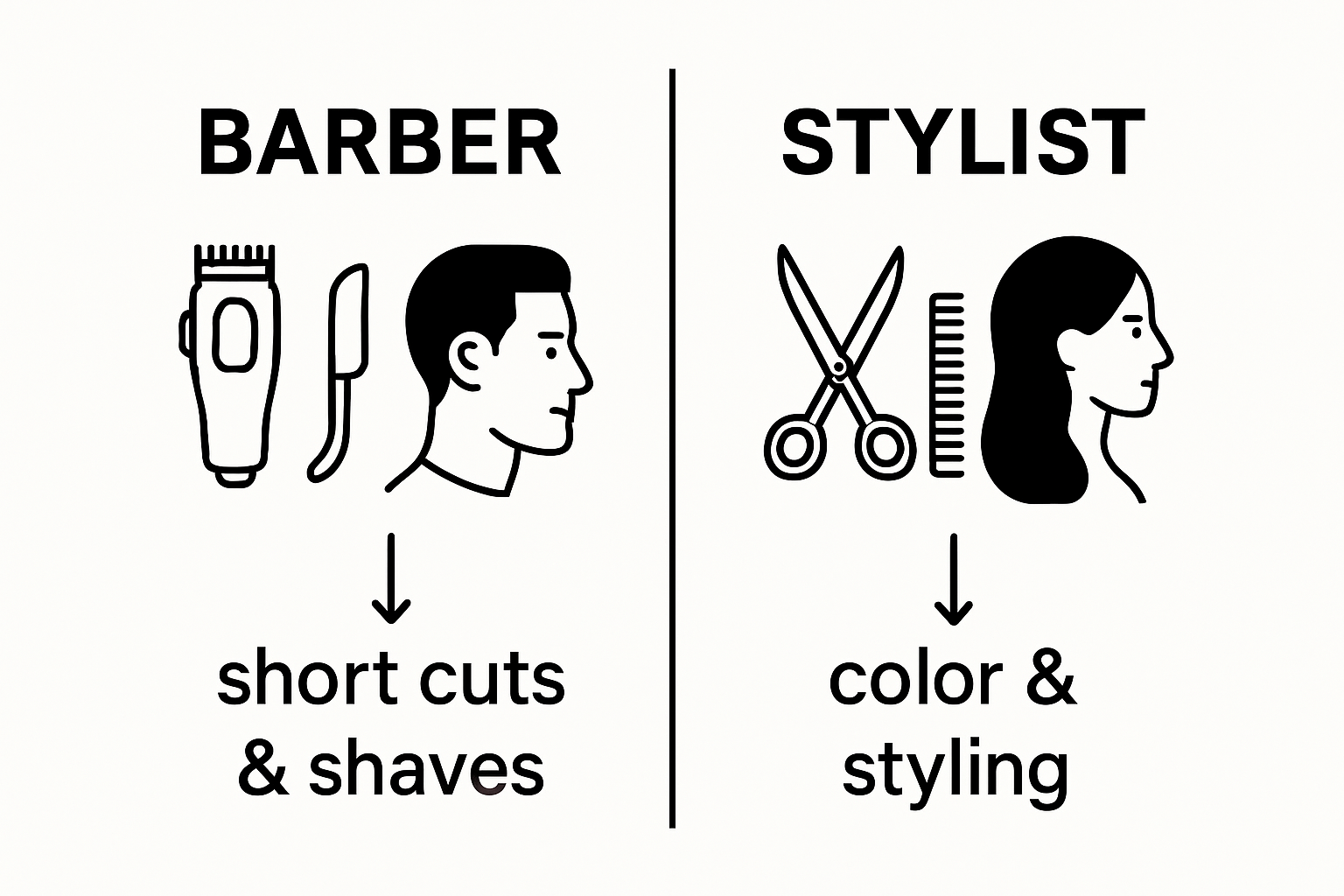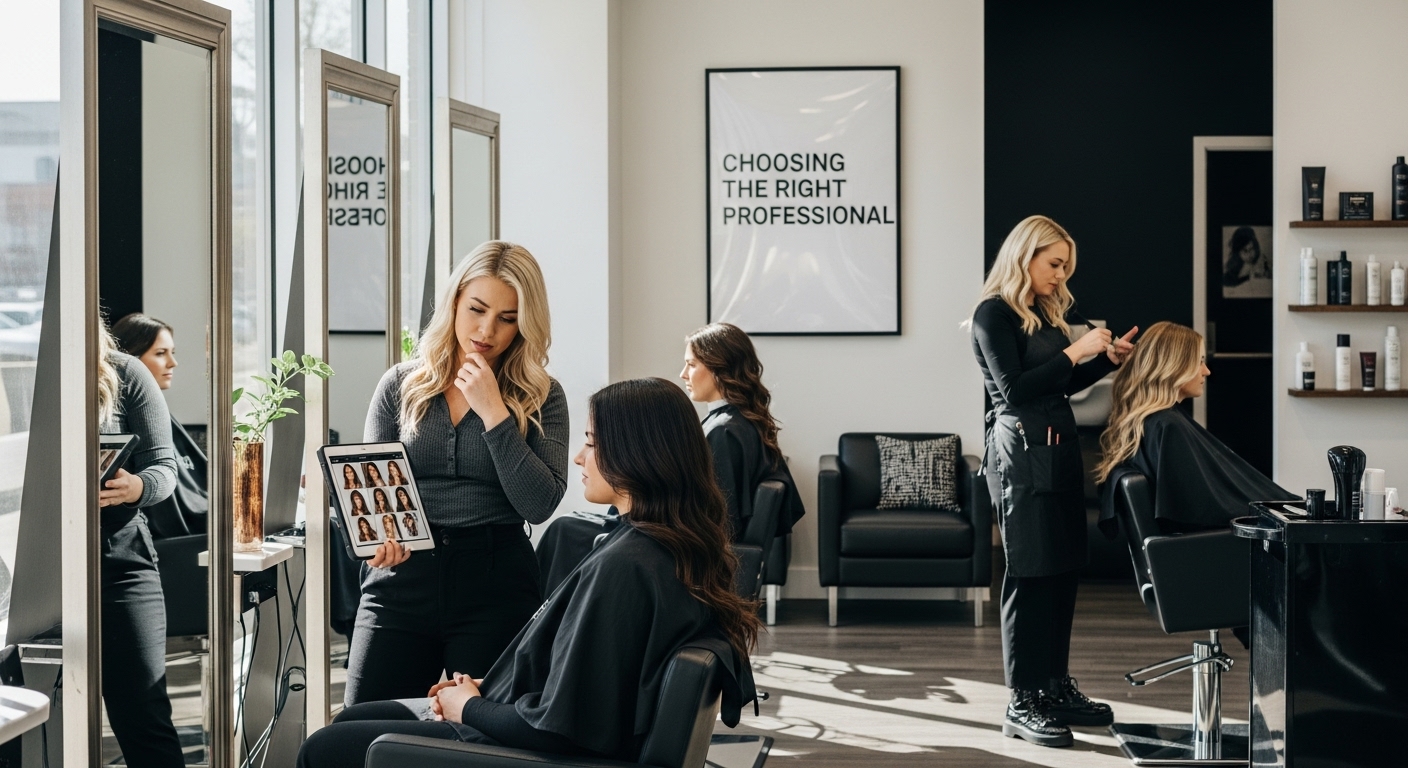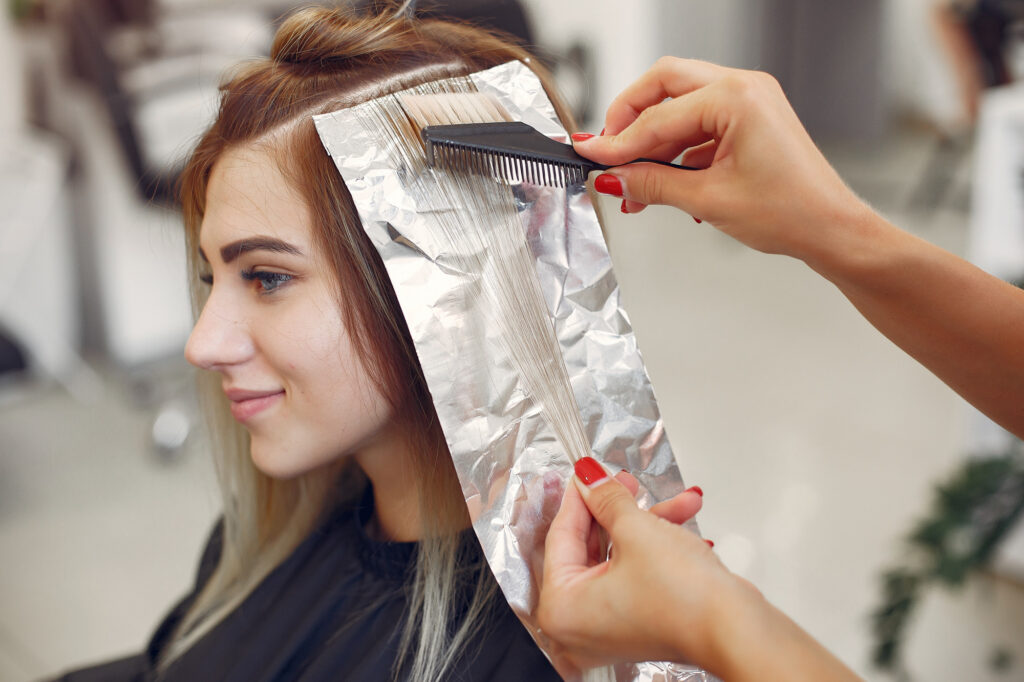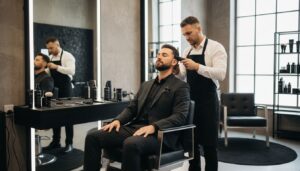Barbers and stylists might look like they do the same job, but their roles could not be more different. Most people are shocked to learn that barbers specialize almost exclusively in classic men’s haircuts and straight razor shaves, while hairstylists train in advanced coloring and complex styling for all hair types. The real surprise is that your choice between the two can totally change how you look, feel, and even how easy your hair is to manage each day.
Table of Contents
- Defining Barbers And Stylists: Key Roles Explained
- The Techniques And Tools Used By Barbers Vs. Stylists
- Understanding Customer Service Approaches: Barbers And Stylists
- Choosing Between A Barber And A Stylist: What Matters Most
Quick Summary
| Takeaway | Explanation |
|---|---|
| Barbers specialize in male grooming services | Barbers focus on haircuts, beard trims, and traditional grooming for men, emphasizing classic styles and techniques. |
| Stylists provide diverse hair care for all genders | Hairstylists offer comprehensive services, including coloring and styling, accommodating various hair types and preferences. |
| Cutting techniques differ significantly | Barbers use precise, geometric cuts with clippers, while stylists utilize fluid techniques and various scissors for more creative styles. |
| Consultation styles vary by professional | Barbers emphasize quick transactions with standardized styles, while stylists engage in detailed consultations for personalized advice. |
| Choose based on hair length and style goals | Your choice of barber or stylist should consider your hair type, preferred length, and complexity of desired styles. |
Defining Barbers and Stylists: Key Roles Explained
Understanding the difference between barbers and stylists goes beyond simply recognizing two professionals who work with hair. These specialists have distinct training, techniques, and service approaches that cater to different client needs and aesthetic preferences.
Professional Training and Focus
Barbers and hairstylists have unique professional paths that shape their expertise. According to the U.S. Bureau of Labor Statistics, their core skills and service areas differ significantly:
- Barbers specialize primarily in male grooming services
- Hairstylists offer comprehensive hair care for all genders
- Training programs reflect these distinct professional requirements

Traditionally, barbers concentrate on classic men’s haircuts, precise beard trimming, and straight razor shaving techniques. Their training emphasizes sharp, clean lines and maintaining traditional male grooming standards. Conversely, hairstylists receive broader training that includes advanced coloring techniques, complex styling methods, and services catering to diverse hair textures and lengths.
Service Scope and Client Experience
The service experience with a barber versus a hairstylist can feel dramatically different. Barber shops often feature a more structured, quick-service environment focused on efficiency and classic masculine aesthetics. They typically provide standardized cut styles with minimal customization.
Hairstylists, in contrast, offer a more personalized consultation approach. They analyze individual hair characteristics, recommend tailored styles, and provide comprehensive hair health advice. Their services extend beyond cutting to include:
- Advanced color treatments
- Complex styling techniques
- Hair texture management
- Personalized hair care recommendations
While both professionals are skilled artisans, their approaches reflect specialized training and client expectations. Understanding these nuances helps individuals choose the right professional for their specific grooming or styling needs.
To clarify the distinctions between barbers and hairstylists, the following table compares their training, primary services, customer interaction styles, and typical client experience.
| Aspect | Barber | Hairstylist |
|---|---|---|
| Training Focus | Classic men’s cuts, beard trimming, straight razor shaves | Advanced coloring, complex styling, hair texture knowledge |
| Typical Services | Haircuts, beard/facial hair grooming, traditional shaves | Haircuts, coloring, styling, treatments for all genders |
| Consultation Style | Brief, efficient, focused on standard styles | In-depth, personalized, considers hair health and preferences |
| Service Environment | Structured, quick, classic masculine atmosphere | Consultative, relaxed, more personalized and creative |
| Tool Emphasis | Clippers, straight razors, trimmers | Multiple scissors, blow dryers, styling and color tools |
| Client Relationship | Transactional, focused on precision and efficiency | Collaborative, ongoing style and care guidance |
| Best Suited For | Short hair, classic and structured styles | Any length/style, creative or complex transformations |
The Techniques and Tools Used by Barbers vs. Stylists
The professional world of hair care is defined not just by who provides the service, but by the intricate techniques and specialized tools each professional employs. Understanding these nuanced differences reveals the artistry behind male grooming and comprehensive hair styling.
Precision Cutting Approaches
According to the U.S. Bureau of Labor Statistics, barbers and hairstylists utilize dramatically different cutting techniques tailored to their specific clientele. Barbers focus on short, structured haircuts using electric clippers and straight razors, creating sharp lines and clean edges characteristic of traditional male hairstyles. Their technique emphasizes geometric precision and uniformity.
Hairstylists, in contrast, employ more fluid cutting methods. They use point cutting, texturizing techniques, and layering approaches that create movement and dimension. Their scissors work involves more nuanced blade angles and cutting patterns designed to complement individual hair textures and face shapes.
Specialized Professional Toolkits
The toolkit of a barber versus a hairstylist reflects their unique service requirements. Barbers typically carry:
- Electric hair clippers with multiple guard sizes
- Straight razors for precise edging
- Professional-grade trimmers
- Traditional shaving implements
Hairstylists, meanwhile, maintain a more extensive toolkit:
- Multiple scissor types for different cutting techniques
- Professional blow dryers
- Ceramic and tourmaline styling tools
- Color processing equipment
- Advanced hair treatment instruments
These specialized tools enable each professional to deliver precise, tailored services that meet distinct client expectations. While barbers craft crisp, structured looks predominantly for male clients, hairstylists create comprehensive hair transformations accommodating diverse styling preferences.
Below is a table highlighting the different cutting techniques and professional tools commonly used by barbers and hairstylists as described in the article.
| Techniques/Tools | Barber | Hairstylist |
|---|---|---|
| Main Cutting Methods | Geometric cuts, clippers, straight razors | Point cutting, layering, texturizing |
| Primary Tools | Clippers, straight razors, trimmers | Scissors (various), blow dryers, color tools |
| Styling Approach | Sharp lines, clean edges, precise looks | Soft lines, movement, creative dimension |
| Color Services | Minimal or none | Extensive, advanced color treatments |
| Hair Type Focus | Short, straight, coarse | All hair lengths, textures and types |
Understanding Customer Service Approaches: Barbers and Stylists
Customer service in professional hair care extends far beyond simply cutting hair. The interaction between a professional and client reveals deep differences in approach, philosophy, and expectations between barbers and hairstylists.
Communication and Consultation Styles
According to the Massachusetts Board of Registration of Cosmetology and Barbering, barbers and hairstylists develop distinctly different communication strategies tailored to their specific clientele. Barber shops traditionally emphasize quick, efficient interactions focused on delivering precise, standardized services. Their consultations are typically brief, with clients expecting straightforward recommendations for classic male grooming styles.
Hairstylists, conversely, engage in more comprehensive consultations. They invest significant time understanding client preferences, analyzing hair texture, face shape, and lifestyle. These professionals offer personalized style recommendations that transform a simple haircut into a holistic personal styling experience. They discuss potential color treatments, maintenance strategies, and long-term hair health.
Client Relationship Dynamics
The relationship dynamics between professionals and clients differ dramatically. Barber shops often maintain a more structured, traditionally masculine environment. Their service model prioritizes:
- Rapid service delivery
- Predictable, classic styling options
- Minimal personal consultation
- Emphasis on precision and uniformity
Hairstylists cultivate a more intimate professional relationship. Their approach includes:
- Detailed personal consultations
- Collaborative style exploration
- Ongoing hair care guidance
- Personalized treatment recommendations
These nuanced differences reflect more than just service variations. They represent distinct professional philosophies about personal grooming and self-expression. Check out our guide on preparing for the perfect haircut to understand how to maximize your salon experience, regardless of whether you choose a barber or a hairstylist.
Choosing Between a Barber and a Stylist: What Matters Most
Selecting the right hair professional is not merely about cutting hair, but finding an expert who understands your personal style, hair type, and aesthetic goals. The decision between a barber and a hairstylist requires careful consideration of multiple factors that extend beyond simple hair maintenance.
Individual Hair Characteristics and Style Preferences
According to the New York State Education Department, different hair professionals are uniquely equipped to handle specific hair types and style requirements. Hair length and texture play crucial roles in determining whether a barber or stylist is the most suitable professional for your needs.
For individuals with shorter hair, particularly men seeking traditional cuts, barbers offer precise, structured approaches. They excel at creating clean, geometric styles that emphasize sharp lines and uniformity. Conversely, hairstylists provide more versatile solutions for those with longer hair, complex textures, or those desiring intricate styling techniques.
Key Decision Factors
Choosing between a barber and a stylist involves evaluating several critical considerations:
- Desired hair length and complexity
- Personal style aesthetic
- Frequency of hair maintenance
- Budget and time constraints
- Specific hair texture requirements
Male clients seeking classic, low-maintenance cuts typically benefit from barber services. These professionals specialize in:
- Quick, efficient haircuts
- Precise beard and facial hair grooming
- Traditional masculine styling approaches
- Standardized cutting techniques
Check out our guide on color and cut options to understand how your choice can impact overall hair health and style. Understanding these nuanced differences ensures you select a hair professional who can truly transform your look and confidence.

Elevate Your Hair Experience With True Professional Expertise
Are you struggling to decide between a barber and a stylist for your next hair transformation? The article explained how choosing the right professional can impact not just your look, but your confidence and sense of self. Many people feel overwhelmed by the differences in training, technique, and service between these roles. If you want more than a standard haircut, and you seek creativity, artistry, or a style tailored just for you, there is a better solution available.

At Joel C Ma Hair Studio, you receive personal attention from a team with over 25 years of advanced experience. Our skilled hair artists combine the precise expertise of both barbers and stylists, offering customized consultations, artistic haircuts, and award-winning color techniques. Discover how our commitment to client care sets us apart by reading more about how to prepare for the perfect haircut and get inspired by exploring the right color and cut choices for your hair. Book your consultation today at Joel C Ma Hair Studio and unlock a new level of confidence and style. Demand a premium experience now. Visit Joel C Ma Hair Studio to get started.
Frequently Asked Questions
What is the main difference between a barber and a stylist?
Barbers primarily focus on male grooming services, offering traditional haircuts and beard trimming, while hairstylists provide comprehensive hair care for all genders and specialize in advanced techniques like coloring and intricate styling.
How does training differ for barbers and hairstylists?
Barbers receive specialized training centered on men’s haircuts and grooming techniques, particularly with clippers and straight razors. Hairstylists, on the other hand, undergo broader training that includes various cutting and coloring techniques suitable for different hair types and styles.
What type of haircuts do barbers typically offer?
Barbers usually provide short, structured haircuts that emphasize clean lines and geometric precision, focusing on classic men’s hairstyles and facial hair grooming.
How do customer service approaches differ between barbers and hairstylists?
Barbers often provide quick, efficient services with brief consultations. In contrast, hairstylists engage in detailed consultations to explore individual needs, offering personalized recommendations for styles and hair care.





